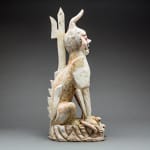Pair of Tang Sculptures of Spirit Guardians, AD 618 - AD 906
Ceramic, Pigment
58.3 x 24 x 25.7 cm
23 x 9 1/2 x 10 1/8 in
23 x 9 1/2 x 10 1/8 in
H.734
Further images
The feline headed beast and humanoid sculptures date from 618 – 906 AD. These two figures are excellent representatives of Spirit Guardians and Mingqi from the Tang Dynasty. Mingqi is...
The feline headed beast and humanoid sculptures date from 618 – 906 AD. These two figures are excellent representatives of Spirit Guardians and Mingqi from the Tang Dynasty. Mingqi is a general terms used in Chinese art referring to objects specifically created for interment in the tombs of elite individuals in order to provide for the afterlife. Chinese spirit guardians are understood to have come in pairs and stood guard over the tombs to ward off any evil-sprits or robbers.
Although these works are supposed to be frightful, the masterfully delicate sculpting of their flaming heads and the gorgeous colors of their Sancai glaze prove more attractive than repelling. Protrusions of horns and flames emerge from their body, remarkably still in tact considering their fragility. Perhaps the most stunning feature of this pair is their back, elegantly painted in orange and black stripes like a tiger. What further sets this pair apart is the unusual presence of a small turtle. Not typically seen at the base of guardian figures the appearance of this amphibian might allude to a ruler, but the substantiated significance has been lost to over the centuries.
The guardians both sit on pedestals with snakes slithering across their feet, a formidable site for any wayward spirit or tomb robber passing by. Generally, guardian figures are understood to be mythological composite creatures, one always a combination of various animals, while the other combined of human and animal traits. In the case the animal figure appears to be a combination of a large cat, dragon with ox hooves, while the humanoid guardian is a mixtures of human, some sort of four legged animal and again with ox hooves.
- (H.734)
Although these works are supposed to be frightful, the masterfully delicate sculpting of their flaming heads and the gorgeous colors of their Sancai glaze prove more attractive than repelling. Protrusions of horns and flames emerge from their body, remarkably still in tact considering their fragility. Perhaps the most stunning feature of this pair is their back, elegantly painted in orange and black stripes like a tiger. What further sets this pair apart is the unusual presence of a small turtle. Not typically seen at the base of guardian figures the appearance of this amphibian might allude to a ruler, but the substantiated significance has been lost to over the centuries.
The guardians both sit on pedestals with snakes slithering across their feet, a formidable site for any wayward spirit or tomb robber passing by. Generally, guardian figures are understood to be mythological composite creatures, one always a combination of various animals, while the other combined of human and animal traits. In the case the animal figure appears to be a combination of a large cat, dragon with ox hooves, while the humanoid guardian is a mixtures of human, some sort of four legged animal and again with ox hooves.
- (H.734)













